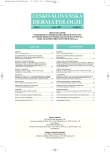Patiens with Primary Lymphoedema Followed in the Lymphology Center of the Department of Dermatology of the 2nd Medical School and Bulovka University Hospital in the Years 2000–2006
Authors:
N. Vojáčková; L. Šipulová; R. Schmiedbergerová; J. Hercogová
Authors‘ workplace:
Dermatovenerologická klinika UK 2. LF a FN Na Bulovce
přednostka prof. MUDr. Jana Hercogová CSc.
Published in:
Čes-slov Derm, 83, 2008, No. 4, p. 187-190
Category:
Clinical and laboratory Research
Overview
Primary lymphoedema is a chronic disease caused by abnormalities of lymphatics, mostly involving lower legs. According to the age of onset it is divided into lymphoedema congenitum, preacox and tardum. From pathophysiological point of view it can be divided into the hypoplastic and hyperplastic hereditary type (Nonne-Milroy syndrome and Meige syndrome, respectively), and idiopathic type. In diagnostics history and physical examination helps to exclude other causes of oedema, in more difficult cases lymphoscintigraphy is performed. The therapy is based on the complex decongestion therapy using combination of manual and instrumental lymphodrainage and compression bandage, in some cases surgical and pharmacological treatment is indicated. In the Lymphology Center of the Department of Dermatology of the 2nd Medical School and Bulovka University Hospital 44 patients with diagnosis of primary lymphoedema were newly treated from January 2000 to December 2006. Diagnosis was made on the basis of history, clinical picture and lymphoscintigraphy. Most patiens underwent the complex decongestion therapy in the phase of oedema reduction. Maintenance therapy is always compressive (bandage, compressive stockings or leggings of II – IV class) including home instrumental therapy in a number of patients. The therapeutical effect is asessed by a regular measurement of extremity perimeter according to the established scheme. Each patient with primary lymphoedema is regularly followed up.
Key words:
primary lymphoedema – lymphoscintigraphy – complex decongestion therapy
Sources
1. Bechyně, M. Mízní otok-lymfedém. Praha. Phlebomedica, 1997.
2. Benda, K., Bařinka, L. Lymfedém končetin. Avicenum, 1981.
3. Brice, G., Child, AH., Bell, R. et al. Milroy disease and the VEGFR-3 mutation phenotype. J Med Genet, 2005, 42, p. 98-102.
4. Byung-Boong, LEE. Lymphoedema-angiodysplasia syndrome: a prodigal form of lymphatic malformation. Lymphology, 2004, 47, p. 324-332.
5. Ely, JW., Osberoff, JE., Chambliss, ML. et al. Approach to leg edema of unclear etiology. J Am Board Fam Med, 2006, 19, p. 148-160.
6. Ghalamkarpour, A., Morlot, S., Raas-Rotschild A. et al. Hereditary lymphedema type I associated with VEGFR3 mutation: the first de novo case atypical presentations. Clin Genet, 2006, 70, p. 330-335.
7. Harel, L., Amir, J., Nussinowitch, M. et al. Lymphedema praecox seen as isolated unilateral arm involvement: Case report and review of the literature. J Ped, 1997, 130, 3, p. 492-494.
8. Heinig, B., Wolina, U. Surgrery in congenital lymphedema: a follow-up of 50 years. Low Extr Wounds, 2003, 2, p. 173-176.
9. Lerner, DS., Klose, G., Cosimi, AB. Effective treatment of lymphedema of the extremities. Arch Surg, 1998, 133, p. 452-458.
10. Meige, H. Dystrophie oedemateuse hereditaire. Presse Méd, 1898, 6, p. 341-343.
11. Milroy, WF. An undescribed variety of hereditary oedema. NY Med J, 1892, 56, p. 505-508.
12. Milroy, WF. Chronic hereditary edema. Milroy’s disease. JAMA, 1928, 91, p. 1172-1175.
13. Štelcl, J., Hudeček, R. Primární lymfedém: kazuistika. Prak Gyn, 2004, s. 16-17.
14. Vignes, S., Dupuy, A. Recurrence of lymphedema-associated cellulitis under prophylactic antibiotherapy: a retrospective cohort study. JEADV, 2006, 20, p. 818-822.
15. Vojáčková, N., Šebková, M., Schmiedbergerová, R. et al. Soubor nemocných s lymfedémem sledovaný v Lymfologickém centru Dermatovenerologické kliniky UK 2. LF a FN Na Bulovce v letech 2000-2005. Retrospektivní analýza. Čas Lék Čes, 2007, 146, s. 57-61.
Labels
Dermatology & STDs Paediatric dermatology & STDsArticle was published in
Czech-Slovak Dermatology

2008 Issue 4
Most read in this issue
- Newer Childhood Viral Exanthemas – Overview
- Case Study of Patient with Blastic NK-cell Lymphoma also Termed CD4+/CD56+ Hematodermic Neoplasia or Early Plasmocytoid Leukaemia/ Dendritic Cell Lymphoma
- Update on the Psoriasis Treatment by Biologics and Standard Systemic Drugs
- Patiens with Primary Lymphoedema Followed in the Lymphology Center of the Department of Dermatology of the 2nd Medical School and Bulovka University Hospital in the Years 2000–2006
